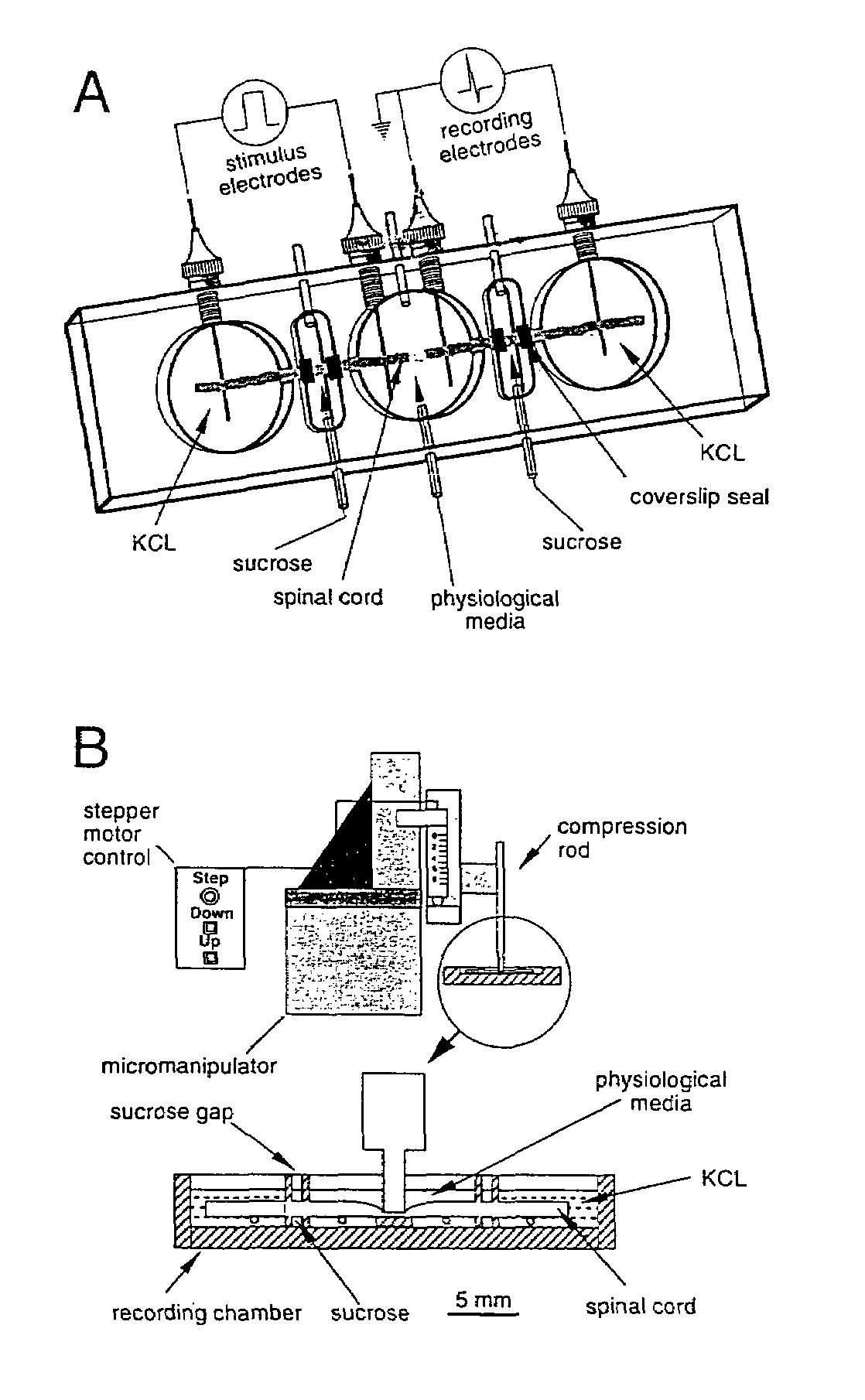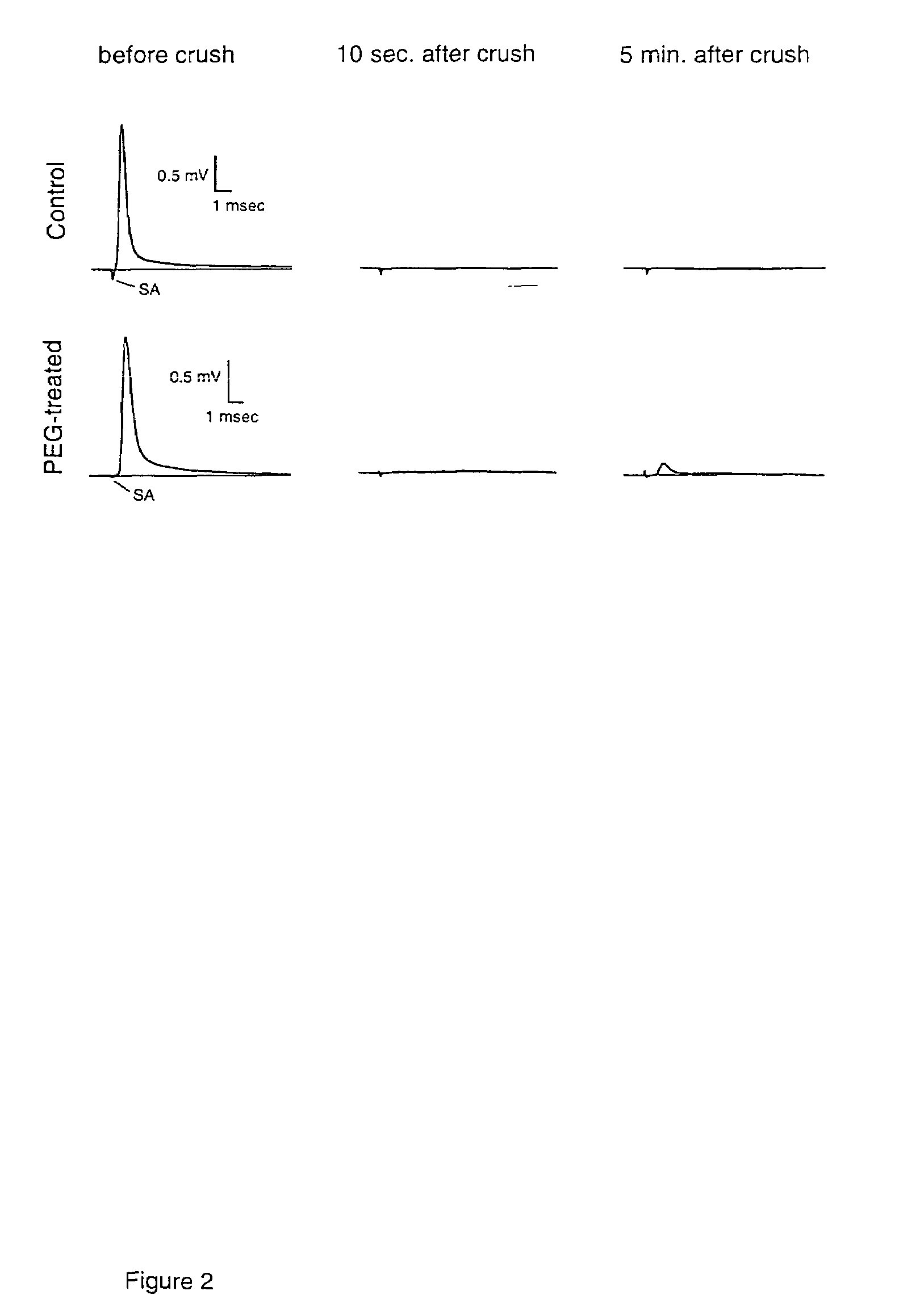Methods and compositions for treating mammalian spinal cord injuries
a technology of spinal cord injury and composition, applied in the field of methods for treating an injured spinal cord, can solve the problem of synergistic treatment of a damaged spinal cord
- Summary
- Abstract
- Description
- Claims
- Application Information
AI Technical Summary
Benefits of technology
Problems solved by technology
Method used
Image
Examples
example 1
Acute In Vitro Response of Crushed Spinal Cord to PEG
[0041]This example demonstrates that compound action potentials are restored in a compressed spinal cord in vitro after it is treated with PEG.
In Vitro Isolation of the Spinal Cord
[0042]Adult female guinea pigs of 350-500 gram body weight were used for these studies. The spinal cord was isolated from deeply anesthetized animals [(60 mg / kg ketamine hydrochloride, 0.6 mg / kg acepromazine maleate, and 10 mg / kg xylazine, intramuscularly (i.m.)]. Following anesthesia, the animal was perfused transcardially with cold (15° C.) Krebs' solution (NaCl, 124 mM; KCl, 2 mM; KH2PO4, 1.2 mM; MgSO4, 1.3 mM; CaCl2, 1.2 mM; dextrose, 10 mM; NaHCO3, 26 mM; sodium ascorbate, 10 mM; equilibrated with 95% O2, and 5% CO2). The vertebral column was rapidly removed using bone forceps and scissors by previously described techniques [Shi, R. and Blight, A. R. (1996) J. of Neurophysiology, 76(3):1572-1579; Shi, R. and Blight, A. R. (1997) Neuroscience 77(2):5...
example 2
Potassium Channel Blockade as an Adjunct to PEG-Mediated Recovery of Conduction
[0059]This example shows that treatment of injured spinal cords in vitro with both a potassium channel blocker and a biomembrane fusion agent allows synergistic recovery of CAPs.
[0060]It is a common feature of injured cells to loose intracellular potassium to the extracellular milieu through compromised membrane. In axons, this may be sufficient to suppress action potential conduction. Thus, it was attempted to determine if blockage of fast potassium channels with 4-AP would affect the properties of conduction immediately following PEG repair.
[0061]Spinal cords were crushed, isolated and treated with PEG as described in example 1. Analysis was also performed in the double sucrose recording chamber as described in example 1.
[0062]FIG. 6A shows the enhancement of the CAP in crushed (but untreated with PEG) spinal cord by 4-AP. In this individual record, the initial recovered CAP at 1 hour post injury is sho...
example 3
Effect of PEG on Restoration of CAPs in Severed Spinal Cord Axons
[0072]This example demonstrates that severed spinal cord axons may be fused with PEG, thus allowing restored conduction of CAPs through the lesion site.
In Vitro Isolation of Spinal Cord
[0073]The spinal cord of adult female guineas pigs was isolated according to the protocol of example 1. After the cord was isolated, it was halved by midline sagittal division. The ventral white matter was separated from gray matter with a scalpel blade against a soft plastic block. Cords were maintained in continuously oxygenated Krebs' solution for at least an hour before mounting in the recording chamber. This was to ensure the recovery from dissection before each experiment was begun.
Double Sucrose Gap Recording Technique
[0074]The technique was followed according to the protocol in example 1. The central bath was connected to instrument ground. The entire chamber was mounted on a Peltier temperature control system, which also maintai...
PUM
| Property | Measurement | Unit |
|---|---|---|
| Time | aaaaa | aaaaa |
| Percent by mass | aaaaa | aaaaa |
| Mass | aaaaa | aaaaa |
Abstract
Description
Claims
Application Information
 Login to View More
Login to View More - R&D
- Intellectual Property
- Life Sciences
- Materials
- Tech Scout
- Unparalleled Data Quality
- Higher Quality Content
- 60% Fewer Hallucinations
Browse by: Latest US Patents, China's latest patents, Technical Efficacy Thesaurus, Application Domain, Technology Topic, Popular Technical Reports.
© 2025 PatSnap. All rights reserved.Legal|Privacy policy|Modern Slavery Act Transparency Statement|Sitemap|About US| Contact US: help@patsnap.com



